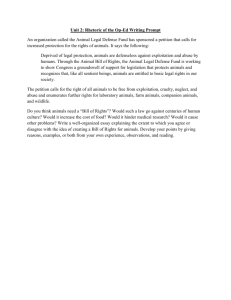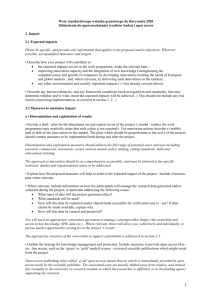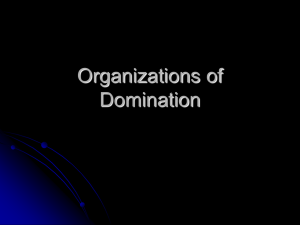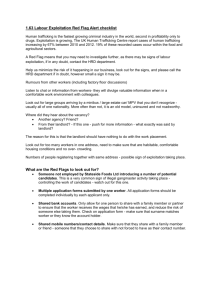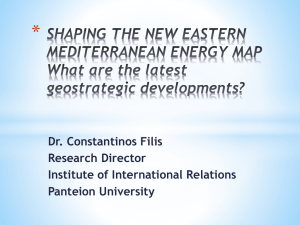Sustainable Management of Natural Resources
advertisement
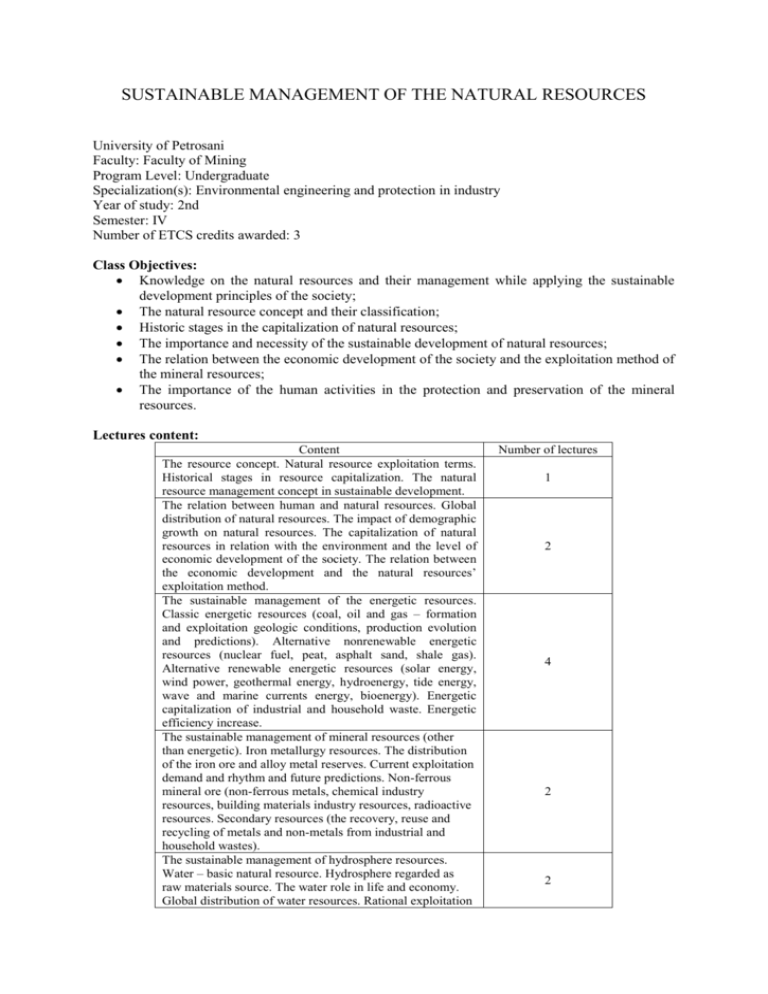
SUSTAINABLE MANAGEMENT OF THE NATURAL RESOURCES University of Petrosani Faculty: Faculty of Mining Program Level: Undergraduate Specialization(s): Environmental engineering and protection in industry Year of study: 2nd Semester: IV Number of ETCS credits awarded: 3 Class Objectives: Knowledge on the natural resources and their management while applying the sustainable development principles of the society; The natural resource concept and their classification; Historic stages in the capitalization of natural resources; The importance and necessity of the sustainable development of natural resources; The relation between the economic development of the society and the exploitation method of the mineral resources; The importance of the human activities in the protection and preservation of the mineral resources. Lectures content: Content The resource concept. Natural resource exploitation terms. Historical stages in resource capitalization. The natural resource management concept in sustainable development. The relation between human and natural resources. Global distribution of natural resources. The impact of demographic growth on natural resources. The capitalization of natural resources in relation with the environment and the level of economic development of the society. The relation between the economic development and the natural resources’ exploitation method. The sustainable management of the energetic resources. Classic energetic resources (coal, oil and gas – formation and exploitation geologic conditions, production evolution and predictions). Alternative nonrenewable energetic resources (nuclear fuel, peat, asphalt sand, shale gas). Alternative renewable energetic resources (solar energy, wind power, geothermal energy, hydroenergy, tide energy, wave and marine currents energy, bioenergy). Energetic capitalization of industrial and household waste. Energetic efficiency increase. The sustainable management of mineral resources (other than energetic). Iron metallurgy resources. The distribution of the iron ore and alloy metal reserves. Current exploitation demand and rhythm and future predictions. Non-ferrous mineral ore (non-ferrous metals, chemical industry resources, building materials industry resources, radioactive resources. Secondary resources (the recovery, reuse and recycling of metals and non-metals from industrial and household wastes). The sustainable management of hydrosphere resources. Water – basic natural resource. Hydrosphere regarded as raw materials source. The water role in life and economy. Global distribution of water resources. Rational exploitation Number of lectures 1 2 4 2 2 of water resources. Water management in extreme hydrologic conditions. Water resources protection. The sustainable management of biopedospheric resources. Soil – hardly renewable natural resource. Soil preservation, reclamation and protection. Forrest resources and their economic role. The distribution of forest resources. The rational exploitation of the forest, the improvement of the forest resources condition and reforestation. Meadows and their economic signification. Biologic aquatic resources. Biodiversity and hunting domain preservation. Nonquantifiable natural resources (the importance of natural domain, landscape and air protection and preservation) The legislation on the sustainable management of natural resources (international conventions and agreements, european directives and romanian legislation). Legislation implementation stage. Strategic development and planning objectives. 2 1 Practical class content: Content The classification of natural resources. The importance and implementation stage of the sustainable development principles in the exploitation, capitalization, protection and preservation of the natural resources in Romania. The distribution, exploitation and capitalization of the natural resources in romania. The role of secondary resources’ capitalization in the protection and preservation of natural resources. Sustainable management possibilities for classic energetic resources (exploitation principles, energy production efficiency increase, reduction of the industrial and household energy consumption). The possibility of using the renewable energetic resources in Romania. The reduction of the exploited natural mineral resource quantity to meet the market demand through increasing their recovery / recycling degree from industrial and household wastes. Implications in the reduction of energy consumption. Visiting a multiple function hydrotechnic facility (energy production, water supply, flood protection, irigations etc.) Sustainable management techniques of the areas for revegetation harvests. The reforestation of cleared areas and the recultivation of degraded areas. Rational use of meadows. The preservation of secular forests and protected areas (national and natural parks, Nature 2000 sites, biosphere and scientific reservations etc.) The preservation of biodiversity, hunting domain and natural landscapes. Paper portfolio presentation Grading Policy: The students pass the class if he obtains mark 5 (out of 10). Final mark shares: - lectures – 60%; - practical class – 40%. Minimum required knowledge for obtaining mark 5: - knowing the resource sustainable management concept; - knowing the natural resource classification; Number of classes 1 1 1 1 1 1 1 - knowing the possibilities for reducing the exploited quantity of natural mineral resources (energetic and non-energetic); knowing the importance of rational and complex exploitation of water resources and their protection; knowing the importance of rational exploitation of the biopedologic resources and the importance of the rehabilitation of degraded areas; knowing the legislation. Classroom Rules of Conduct: Turn off (or place on vibrate) cell phones and pagers during class; During exams, the use of cell phones, pagers, PDAs, or any other electronic devices is strictly prohibited. Lecturer: Emilia DUNCA e-mail: emydunca@gmail.com
